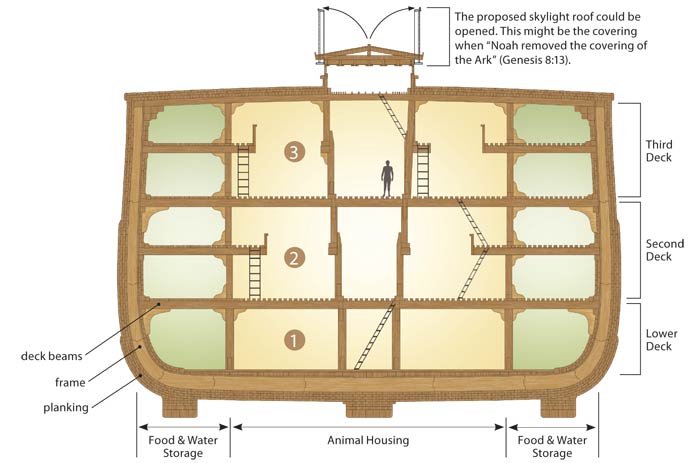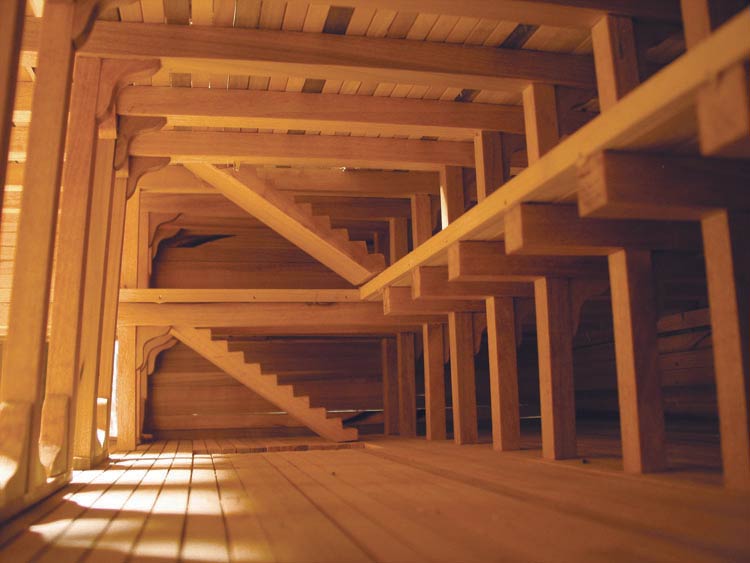How Did The Animals On The Ark Eat
While it is possible that God made miraculous provisions for the daily care of these animals, it is not necessary—or required by Scripture—to appeal to miracles.
According to Scripture, Noah's Ark was a safe haven for representatives of all the kinds of air-breathing land animals that God created. While information technology is possible that God fabricated miraculous provisions for the daily care of these animals, information technology is not necessary—or required by Scripture—to appeal to miracles. Exploring natural solutions for day-to-day operations does not discount God's role: the biblical account hints at plenty of miracles as written, such as God bringing the animals to the Ark (Genesis 6:20; 7:9, fifteen). It turns out that a written report of existing, low-tech animal care methods answers trivial objections to the Ark. In fact, many solutions to seemingly insurmountable issues are rather straightforward.
How Did Noah Fit All the Animals on the Ark?
According to the Bible, the Ark had three decks (floors). It is not difficult to show that there was plenty of room for 16,000 animals (the maximum number of animals on the Ark, if the most liberal arroyo to counting animals is applied), bold they required approximately the same floor infinite as animals in typical farm enclosures and laboratories. The vast majority of the creatures (birds, reptiles, and mammals) were small (the largest merely a few hundred pounds of body weight). What's more, many could have been housed in groups, which would have further reduced the required space.
It is still necessary to take business relationship of the floor spaces required by large animals, such as elephants and rhinos. Just even these, collectively, do not require a large surface area because it is near likely that these animals were young, just not newborns. Fifty-fifty the largest dinosaurs were relatively modest when only a few years one-time.
What Did the Dinosaurs Eat?
Dinosaurs could take eaten basically the same foods as the other animals. The big sauropods could have eaten compressed hay, other dried institute material, seeds and grains, and the like. Carnivorous dinosaurs—if any were meat-eaters before the Inundation—could take eaten stale meat, reconstituted dried meat, or slaughtered animals. Giant tortoises would accept been ideal to employ as food in this regard. They were large and needed little food to exist maintained themselves. There are also exotic sources of meat, such as fish that wrap themselves in dry out cocoons.
It is not necessary—or required by Scripture—to appeal to miracles for the provision and daily care of the animals on the Ark. Many solutions to seemingly insurmountable problems are rather straightforward.
How Were the Animals Cared For?
We must distinguish betwixt the long-term care required for animals kept in zoos and the temporary, emergency care required on the Ark. The animals' comfort and healthy appearance were not essential for emergency survival during one stressful year, where survival was the primary goal.
Studies of nonmechanized animal care indicate that eight people could have fed and watered sixteen,000 creatures. The key is to avert unnecessary walking around. As the old adage says, "Don't work harder, work smarter."
Therefore, Noah probably stored the food and h2o well-nigh each animal. Fifty-fifty better, drinking water could take been piped into troughs, just as the Chinese accept used bamboo pipes for this purpose for thousands of years. The use of some sort of self-feeders, as is commonly done for birds, would have been relatively piece of cake and probably essential. Animals that required special care or diets were uncommon and should not have needed an inordinate amount of fourth dimension from the handlers. Fifty-fifty animals with the nigh specialized diets in nature could have been switched to readily sustainable substitute diets. Of class, this assumes that animals with specialized diets today were as well specialized at the time of the Flood.
How Did the Animals Breathe?
Based on my two decades of research, I do not believe that anything more was needed than a bones, non-mechanical ventilation system. The density of animals on the Ark, compared to the book of enclosed space, was much less than we notice in some modern, mass animal housing used to keep stock raised for food (such every bit craven farms), which requires no special mechanical ventilation.
Information technology is reasonable to believe that i relatively small window would have adequately ventilated the Ark. Of course if there were a window along the top center department, which the Bible allows, all occupants would be even more comfortable. It is likewise interesting to note that the convective motion of air, driven by temperature differences between the warm-blooded animals and the cold interior surfaces, would have been meaning plenty to drive the flow of air. Plus, wind blowing into the window would accept enhanced the ventilation further. Nonetheless, if supplementary ventilation was necessary, information technology could have been provided by moving ridge motion, fire thermal, or even a small number of animals harnessed to ho-hum-moving rotary fans.
What Did Noah and His Family Do with the Beast Waste material?
As much equally 12 U.S. tons (11 thou. tons) of creature waste may accept been produced daily. The key to keeping the enclosures clean was to avoid the need for Noah and his family to practice the piece of work. The right systems could besides forbid the need to alter animal bedding. Noah could have accomplished this in several ways. One possibility would be to allow the waste product to accumulate below the animals, much every bit we see in modern pet shops. In this regard, there could have been slatted floors, and animals could have trampled their waste into the pits below. Modest animals, such every bit birds, could have multiple levels in their enclosures, and waste could accept simply accumulated at the lesser of each.

Beast enclosures with sloped, self-cleaning floors, elimination into a manure gutter or pit.
The danger of toxic or explosive manure gases, such every bit methane, would be alleviated by the abiding motion of the Ark, which would accept immune manure gases to exist constantly released. Secondly, methane, which is one-half the density of air, would quickly find its mode out of a small opening such as a window. There is no reason to believe that the levels of these gases inside the Ark would have approached hazardous levels.
Alternatively, sloped floors would have immune the waste to flow into large cardinal gutters. Noah'due south family could accept then dumped this overboard without an excessive expenditure of manpower.
The problem of manure smell may, at first thought, seem insurmountable. But we must remember that, throughout most of human history, humans lived together with their subcontract animals. Barns, split from human living quarters, are a relatively recent evolution.
While the voyage of the Ark may not have been comfortable or like shooting fish in a barrel, it was certainly doable, even under such unprecedented circumstances.
A Await Within the Ark
This is a cross-section view of a possible pattern of the interior of the Ark.

Three Decks
Genesis six:16 instructs that the Ark is to exist made "with lower, 2d, and third decks" (NKJV). In this version of the Ark'due south interior, there are two levels that do not extend beyond the unabridged width of the ship. These one-half-floors are not divide levels.
Animal Housing
Genesis 6:14 instructs Noah to "brand rooms [nests] in the ark" (NKJV). These rooms or nests would simply exist stalls and cages for the animals.

Model created by Tim Foley.
This scale model shows the constructive design of Noah's Ark. This 2nd-floor model shows the actress one-half-flooring within the three deck construction that could have been used for possible storage or animal housing.
Stairs
Several staircases and ladders could exist fitted throughout the Ark to gain quick admission to another deck. Ramps nearly the ends of the hull (every bit seen in Thinking Outside the Box) could be used to become animals and heavy loads between decks.
Food & Water
Mezzanine levels meliorate access to food storage, utilizing gravity to supply grain and water to the animal enclosures beneath. H2o could be directed in pipes (metal, wood, leather, bamboo, etc.) from tanks on upper levels.
Low-cal & Ventilation
The key skylight provides lighting and ventilation to the middle section of the Ark. Slatted floors maximize airflow to the lower decks.
Source: https://answersingenesis.org/noahs-ark/caring-for-the-animals-on-the-ark/
Posted by: arnoldtherstion1975.blogspot.com

0 Response to "How Did The Animals On The Ark Eat"
Post a Comment